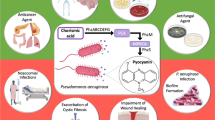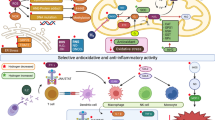Abstract
The capability of halocin H6 (a bacteriocin-like protein produced by haloarchaeaHaloferax gibbonsii) to inhibit Na+/H+ exchange (NHE) in mammalian cells and its cardio-protective efficacy on the ischemic and reperfused myocardium were evaluated in the present study. H6 inhibits NHE activity (measured by a flow cytometry method) in a dose-dependent form of cell lines of mammalian origin (HEK293, NIH3T3, Jurkat and HL-1) as well as in primary cell culture from human skeletal muscle (myocytes and fibroblasts).In vivo, an ischemia-reperfusion model in dogs by coronary arterial occlusion was used (two hours of regional ischemia and three hours of reperfusion). In animals treated with halocin H6 there was a significant reduction of premature ventricular ectopic beats and infarct size, whereas blood pressure and heart rate remained unchanged. Up to date, halocin H6 is the only described biological molecule that exerts a, specific inhibitory activity in NHE of eukaryotic cells.
Resumen
En el presente trabajo se evalúa la capacidad de la halocina H6 (una proteína tipo bacteriocina producida por la haloarchaeaHaloferax gibbonsii) para inhibir el intercambiador Na+/H+ (NHE) de céludas de mamífero y su posible eficacia cardioprotectora frente a los daños causados por isquemia-reperfusión del miocardio. En experimentosin vitro H6 inhibe la actividad de NHE (determinada por citometría de flujo) de forma dosis-dependiente tanto en líneas celulares de mamíferos (HEK293, NIH3T3, Jurkat y HL-1) como en cultivos primarios de miocitos y fibroblastos aislados de músculo esquelético humano. En experimentosin vivo se utilizó un modelo de isquemia-reperfusión en perros por oclusión de la arteria coronaria (dos horas de isquemia y tres de reperfusión). En animales tratados con halocina H6 se produjo una disminución significativa a nivel estadístico, tanto del número de latidos ectópicos ventriculares como del tamaño del infarto, mientras que no se produjeron cambios tanto en la presión sanguínea como en el ritmo cardíaco. Hasta la fecha la halocina H6 es la única molécula biológica descrita que ejerce una actividad inhibidora específica sobre el NHE de células eucariotas.
Similar content being viewed by others
References
Avkiran, M. (1999):Circulation,100, 2469–2472.
Chou, S. and Hedley, D. (1997):Current Protocols in cytometry, 9.3.1.–9.3.10.
Cingolani, H. E., Chiappe, G. E., Ennis, I. L., Morgan, P. G., Alvarez, B. V., Casey, J. R., Dulce, R. A., Perez, N. G., and Camilion De Hurtado, M. C. (2003):Circ. Res.,93, 1082–1088.
Claycomb, W. C., Lanson, N. A., Jr., Stallworth, B. S., Egeland, D. B., Delcarpio, J. B., Bahinski, A., and Izzo, N. J., Jr. (1998):Proc. Natl. Acad. Sci. U. S. A.,95, 2979–2984.
Counillon, L. and Pouyssegur, J. (2000):J. Biol. Chem.,275, 1–4.
Dennis, S. C., Gevers, W., and Opie, L. H. (1991):J. Mol. Cell Cardiol.,23, 1077–1086.
Dibrov, P. and Fliegel, L. (1998):FEBS Lett.,424, 1–5.
Dolz, M., O’Connor, J. E., and Lequerica, J. L., (2004):Cytometry,61A, 99–104.
Frelin, C., Vigne, P., and Lazdunski, M. (1985):Eur. J. Biochem.,149, 1–4.
García-Dorado, D., González, M. A., Barrabes, J. A., Ruiz-Meana, M., Solares, J., Lidon, R. M., Blanco, J., Puigfel, Y., Piper, H. M., and Soler-Soler, J. (1997):Cardiovasc. Res.,35, 80–89.
Goldberg, S. P., Digerness, S. B., Skinner, J. L., Killingsworth, C. R., Katholi, C. R., and Holman, W. L. (2002):Ann. Thorac. Surg.,73, 569–574.
Inserte, J., García-Dorado, D., Ruiz-Meana, M., Padilla, F., Barrabes, J. A., Pina, P., Agullo, L., Piper, H. M., and Soler-Soler, J. (2002):Cardiovasc. Res.,55, 739–748.
Karmazyn, M. and Moffat, M. P. (1993):Cardiovasc. Res.,27, 915–924.
Knight, D. R., Smith, A. H., Flynn, D. M., MacAndrew, J. T., Ellery, S. S., Kong, J. X., Marala, R. B., Wester, R. T., Guzmán-Pérez, A., Hill R. J., Magee, W. P., and Tracey, W. R. (2001):J. Pharmacol. Exp. Ther.,297, 254–259.
Lanyi, J. K. and Silverman, M. P. (1979):J. Biol. Chem.,254, 4750–4755.
Lazdunski, M., Frelin, C., and Vigne, P. (1985):J. Mol. Cell Cardiol.,17, 1029–1042.
Lequerica, J. L., Mirabet, V., Montero, J. A., Hurtado, C., Piquer, S., and Carbonell, F. (1999):Ann. Transplant.,4, 103–108.
Meseguer, I. and Rodríguez-Valera, F. (1986):J. Gen Microbiol,132, 3061–3068.
Meseguer, I., Torreblanca, M., and Konishi, T. (1995):J. Biol. Chem.,270, 6450–6455.
Nachlas, M. M. and Shnttka, T. K. (1963):Am. J. Pathol.,42: 379–405, 379–405.
Neylon, C. B., Little, P. J., Cragoe, E. J., Jr., and Bobik, A. (1990):Circ. Res.,67, 814–825.
Rodríguez-Varela, F., Juez, G., and Kushner, D. J. (1982):Can. J. Microbiol.,28, 151–154.
Schafer, C., Ladilov, Y. V., Schafer, M., and Piper, H. M. (2000):Am. J. Physiol Heart Circ. Physiol,279, H2143-H2150.
Schafer, C., Ladilov, Y. V., Siegmund, B., and Piper, H. M. (2000):Am. J. Physiol. Heart Circ. Physiol.,278, H1457-H1463.
Schmid, A., Scholz, W., Lang, H. J., and Popp, R. (1992):Biochem. Biophys. Res. Commun.,184, 112–117.
Scholz, W. and Albus, U. (1995):Cardiovasc. Res.,29, 184–188.
Scholz, W., Albus, U., Lang, H. J., Linz, W., Martorana, P. A., Englert, H. C., and Scholkens, B. A. (1993):Br. J. Pharmacol.,109, 562–568.
Scholz, W., Albus, U., Linz, W., Martorana, P., Lang, H. J., and Scholkens, B. A. (1992):J. Mol. Cell Cardiol.,24, 731–739.
Stromer, H., de Groot, M. C., Horn, M., Faul, C., Leupold, A., Morgan, J. P., Scholz, W., and Neubauer, S. (2000):Circulation,101, 2749–2755.
Tani, M. and Neely, J. R. (1990):J. Mol. Cell Cardiol.,22, 57–72.
Ten Hove, M., van Emous, J. G., and van Echteld, C. J. (2003):Mol. Cell Biochem.,250, 47–54.
Torreblanca, M., Meseguer, I., and Rodríguez-Varela F. (1989):J. Gen. Microbiol.,135, 2655–2661.
Toyoda, Y., Khan, S., Chen, W., Parker, R. A., Levitsky, S., and McCully, J. D. (2001):Ann. Thorac. Surg.,72, 836–843.
Yasutake, M., Ibuki, C., Hearse, D. J., and Avkiran, M. (1994):Am. J. Physiol.,267, H2430-H2440.
Author information
Authors and Affiliations
Corresponding author
Rights and permissions
About this article
Cite this article
Lequerica, J.L., O’Connor, J.E., Such, L. et al. A halocin acting on Na+/H+ exchanger of Haloarchaea as a new type of inhibitor in NHE of mammals. J. Physiol. Biochem. 62, 253–262 (2006). https://doi.org/10.1007/BF03165754
Received:
Issue Date:
DOI: https://doi.org/10.1007/BF03165754
Key words
- Na+/H+ antiporter inhibition
- Haloarchaea
- Halocin H6
- Ischemia-reperfusion
- Myocardial infarction
- Animal model




